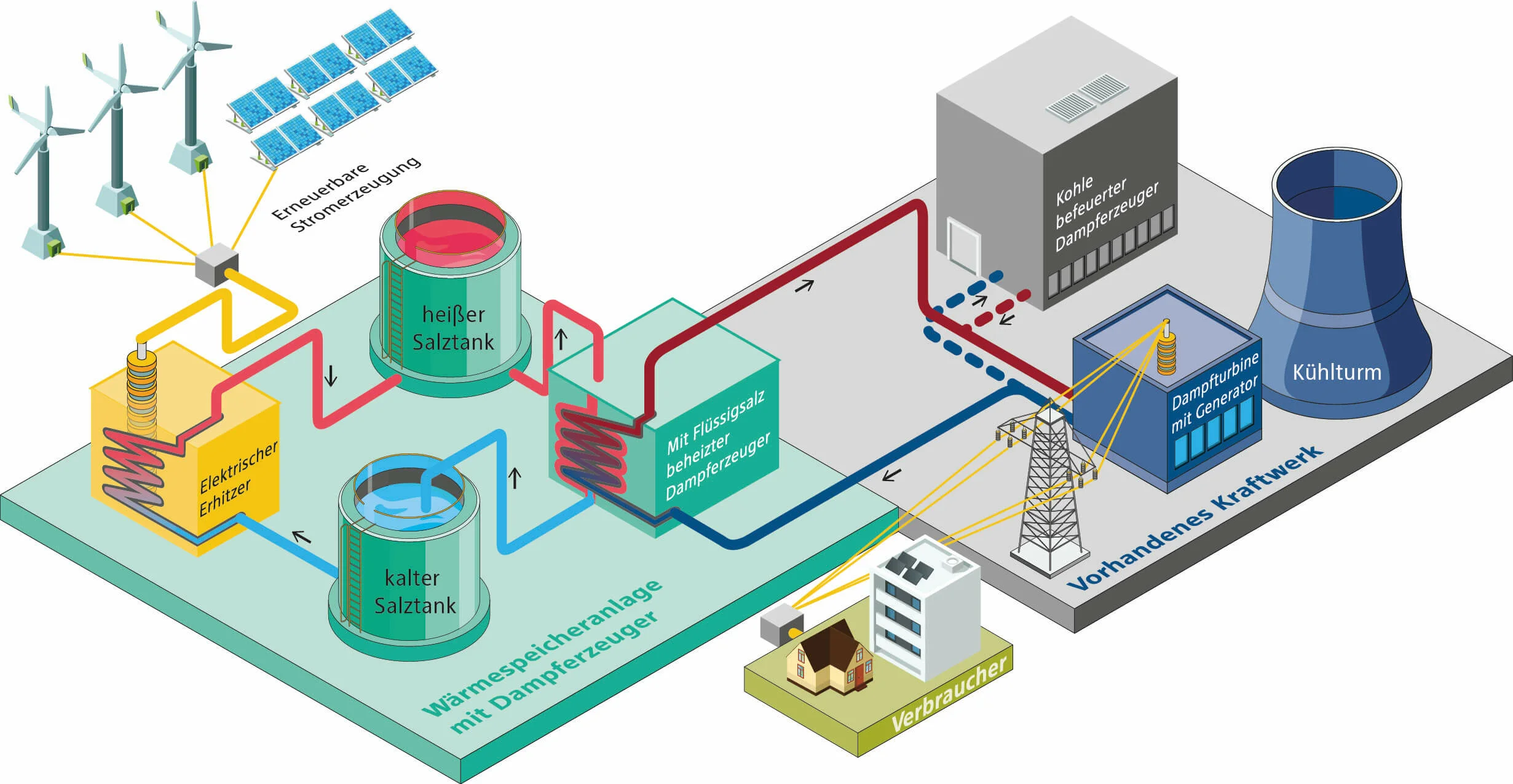For a long time it was nothing more than a stroke of genius, hidden in the coalition agreement between the SPD and CDU. And when little progress was made at the pivotal meeting of the Growth, Structural Change and Employment Commission in late January, these appendixes were allegedly an integral part of the final compromise: Heat storage power plants could be the technology to combine the renewable and fossil (energy) worlds.
RWE Power is now taking its first step into this new world together with the German Aerospace Centre (DLR) and Aachen University of Applied Sciences: The trio is planning a pilot project for liquid salt-based energy storage in the Rhenish mining region and an existing coal-fired power plant is to be converted into a heat storage power plant (HSP) for this purpose. In this way, innovative facilities are being created that will be able to ensure security of supply even once the phase-out of coal-fired power generation is complete.
Known technology in a new location
Liquid salt has long been used as an energy source in the large solar farms of Southern Europe, which operate with concentrated sunlight. No wonder: Heat can be stored three times more efficiently with salt than with water. But how can this technology be applied to coal-fired power stations? Salt is heated with surplus energy in an electric heater to up to 600 degrees. It liquefies and can then be stored in tanks. When energy is needed, the molten salt is pumped from the hot tank via a steam generator into a colder tank. The steam generated in this way is fed into the turbine circuit of the power plant unit to generate electricity. There, it replaces part of the steam otherwise produced with coal.
As a hybrid power plant, the HSP will initially run on renewable electricity and coal in tandem. This not only increases the flexibility of the system, it also dissociates the production of green power from its feed-in. Thus, volatile green energy is transformed into eco-energy. Wind, photovoltaics, etc. could – together with fossil power plants – make a contribution to security of supply.
But, this is only the first step: With the progressive expansion of renewable energy and the recent decision to gradually phase out coal-fired power generation – a decision which is yet to be finalised and legally outlined – the capacity of the heat storage facility can be expanded, while the use of lignite can be reduced. After the end of coal-fired power generation, the heat storage power plant can then be operated entirely with renewable energy.
“Thermal storage systems offer the potential to be ideal energy storage systems, based on their gigawatt per hour rates” emphasises Prof. André Thess, Director of the DLR Institute of Technical Thermodynamics. “We need high-performance energy storage systems with a high degree of efficiency. They are of vital importance for a future energy system based on renewable energy.” It will only be possible to bridge the strong fluctuations in the production of environmentally friendly wind and solar energy with the help of storage systems which will also enable the similarly highly dynamic demand for energy to be met. This would balance demand and production.
Support from the state of North Rhine-Westphalia
The idea is also well received by politicians. NRW supports the project proposal and has included it as a key project in the immediate-action programme entitled ‘The Rhenish Coal-Mining Region of the Future’. As part of its ‘progress.nrw’ funding programme, NRW is backing the planning work on the first station of this type with 2.9 million euros in funding. The project partners also intend to apply for federal funding to implement the project.
“The planned heat storage power plant is the ideal lighthouse project for The Rhenish Coal-Mining Region of the Future,” says Andreas Pinkwart, Minister for Economic Affairs, Innovation, Digitisation and Energy in North Rhine-Westphalia. “It makes it possible to create value and more jobs in a region which is affected by structural change.”
Lars Kulik, member of the Executive Board of RWE Power, also sees the great potential for both energy system transformation and structural change in the Rhenish region: “If the technology proves its worth, heat storage facilities could help ensure that our Rhenish power plant sites continue to play an integral role in energy supply even after the phase-out of coal-based power generation.”
The planned heat storage power plant is an outstanding lead project for the Rheinische Zukunftsrevier. Andreas Pinkwart, Minister for Economic Affairs, Innovation, Digitization and Energy in North Rhine-Westphalia
And there is a good chance that this will be the case, given the other great advantage of this type of plant: It will be possible to continue using the existing power station infrastructure, such as grid connections and turbines. This lowers the costs as only the supply of the raw material and the storage facilities will need to be changed. In this way, the conversion can save immense costs as well as jobs, by largely keeping the existing infrastructure from the power plants’ ‘first life’.
The goal of RWE Power, DLR and FH Aachen is clear: The pilot plant is to be built and operated to subject liquid salt heat storage to an extensive field trial. It is not yet clear which power plant will be selected for this purpose. But one thing is certain: it will be in the Rhenish coal mining region. Based on current plans, construction of the plant could begin as soon as the early 2020s.

